|
|
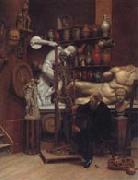 |
Samuel Butler
|
|
British author , (1835 - 1902)
Samuel Butler was born on Dec. 4, 1835, in Langar, near Bingham, Nottinghamshire, the son of the local vicar. In a time of common paternal absolutism, his childhood seems to have been bleak and graceless. After taking a degree at Cambridge, he came into open conflict with his father over the question of his future profession, and at last he emigrated to New Zealand to become a sheep farmer. But though free of his father, he was not free of revolt, and the spirit of resentful rebelliousness marked much of his later life. In New Zealand he read Charles Darwin's Origin of Species and wrote a series of newspaper articles setting forth Darwin's ideas and ingeniously applying the evolutionary hypothesis to machines. Having made a modest fortune, he returned to England in 1864. Erewhon (1872), Butler's first book, is a mixture of satire, utopian theories, and serious speculation masked as whimsy. Set in the frame of a trip to an unknown land (Erewhon is an anagram of "no-where"), it has no real plot but is rather a description and discussion of the customs and institutions of Erewhon. In this land moral failings are treated as mental illness and cured by a "straightener," but physical illness and misfortune are considered crimes and severely punished. Children sign certificates absolving their parents of responsibility for their birth, and education is carried on in the College of Unreason. Butler's reflections on orthodox religion, begun in New Zealand, issued in The Fair Haven (1873), an ironic attempt to reconcile the New Testament with rationalistic criticism. In Life and Habit he returned to the question of evolution. In Evolution Old and New (1879), Unconscious Memory (1880), and Luck, or Cunning? (1887), he developed his ideas with an increasingly self-righteous resentment of what he conceived to be the Darwinians' deliberate concealment of the truth. Butler hoped to be able to restore will, intelligence, and design to a universe apparently made meaningless by the blind process of natural selection. The novel The Way of All Flesh, Butler's most famous work, was written between 1872 and 1885. It is the supposed biography of Ernest Pontifex, narrated by an older friend with an unrelenting candor deliberately affronting conventional pieties. |
|
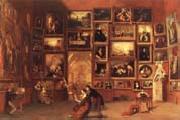 |
Samuel FB Morse
|
|
1791-1872,American painter and inventor. The son of a Calvinist minister, he began amateur sketching while a student at Yale College, New Haven, CT. After graduating in 1810, he returned to Charlestown, MA, to paint family portraits. In Boston in the same year he met Washington Allston, recently returned from Italy, under whose tutelage he executed his first history painting, the Landing of the Pilgrims at Plymouth (c. 1810-11; Boston, MA, Pub. Lib.). He joined Allston on his trip to London in 1811, enrolled in the Royal Academy Schools and also studied privately with Allston and Benjamin West. Morse Dying Hercules (1812-13; New Haven, CT, Yale U. A.G.), based on the pose and musculature of the Laokoon (Rome, Vatican, Mus. Pio-Clementino) and the theory evident in Allston Dead Man Restored to Life by Touching the Bones of the Prophet Elisha (1811-14; Philadelphia, PA Acad. F.A.), was critically acclaimed when exhibited at the Royal Academy and is indicative of Morse academic interests. After two trips in 1813 and 1814 to Bristol, where he painted a number of portraits and small subject pieces, Morse ended his period in England with another mythological history painting, the Judgement of Jupiter (1814-15; New Haven, CT, Yale U. A.G.). |
|
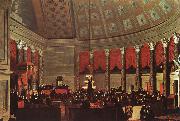 |
Samuel Finley Breese Morse
|
|
1791-1872
Samuel F.B. Morse was born on April 27, 1791 in Charlestown, Massachusetts, the first child of geographer and Pastor Jedidiah Morse (1761-1826) and Elizabeth Ann Breese (1766-1828). Jedidiah was a great preacher of the Calvinist faith and supporter of the American Federalist party. He not only saw it as a great preserver of Puritan traditions (strict observance of the Sabbath), but believed in its idea of an alliance with English in regards to a strong central government. Jedidiah strongly believed in education within a Federalist framework alongside the instillation of Calvinist virtues, morals and prayers for his son. After attending Phillips Academy in Andover, Massachusetts, Samuel Morse went on to Yale College to receive instruction in the subjects of religious philosophy, mathematics and science of horses. While at Yale, he attended lectures on electricity from Benjamin Silliman and Jeremiah Day. He earned money by painting. In 1810, he graduated from Yale.
Morse's Calvinist beliefs are evident in his painting the Landing of the Pilgrims, through the depiction of simplistic clothing as well as the austere facial features. This image captured the psychology of the Federalists; Calvinists from England brought to the United States ideas of religion and government thus forever linking the two countries. More importantly, this particular work attracted the attention of the famous artist, Washington Allston. Allston wanted Morse to accompany him to England to meet the artist Benjamin West. An agreement for a three- year stay was made with Jedidah, and young Morse set sail with Allston aboard the Lydia on July 15, 1811 (1).
Upon his arrival in England, Morse diligently worked at perfecting painting techniques under the watchful eye of Allston; by the end of 1811, he gained admittance to the Royal Academy. At the Academy, he fell in love with the Neo-classical art of the Renaissance and paid close attention to Michelangelo and Raphael. After observing and practicing life drawing and absorbing its anatomical demands, the young artist successfully produced his masterpiece, the Dying Hercules.
To some, the Dying Hercules seemed to represent a political statement against the British and also the American Federalists. The muscles apparently symbolized the strength of the young and vibrant United States versus the British and British-American supporters. During Morse??s time in Britain the Americans and English were engaged in the War of 1812 and division existed within United States society over loyalties. Anti-Federalists Americans aligned themselves with the French, abhorred the British, and believed a strong central government to be inherently dangerous to democracy.(3) As the war raged on, his letters to his parents became more anti-Federalist in their tones. In one such letter Morse said, "I assert that the Federalists in the Northern States have done more injury to their country by their violent opposition measures than a French alliance could. Their proceedings are copied into the English papers, read before Parliament, and circulated through their country, and what do they say of them... they call them (Federalists) cowards, a base set, say they are traitors to their country and ought to be hanged like traitors." |
|
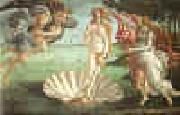 |
Sandro Botticelli
|
|
Italian Early Renaissance Painter, 1445-1510
Italian painter and draughtsman. In his lifetime he was one of the most esteemed painters in Italy, enjoying the patronage of the leading families of Florence, in particular the Medici and their banking clients. He was summoned to take part in the decoration of the Sistine Chapel in Rome, was highly commended by diplomatic agents to Ludovico Sforza in Milan and Isabella d Este in Mantua and also received enthusiastic praise from the famous mathematician Luca Pacioli and the humanist poet Ugolino Verino. By the time of his death, however, Botticelli s reputation was already waning. He was overshadowed first by the advent of what Vasari called the maniera devota, a new style by Perugino, Francesco Francia and the young Raphael, whose new and humanly affective sentiment, infused atmospheric effects and sweet colourism took Italy by storm; he was then eclipsed with the establishment immediately afterwards of the High Renaissance style, which Vasari called the modern manner, in the paintings of Michelangelo and the mature works of Raphael in the Vatican. From that time his name virtually disappeared until the reassessment of his reputation that gathered momentum in the 1890s |
|
|
|
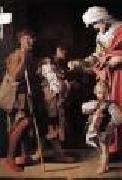 |
SCHEDONI, Bartolomeo
|
|
Italian painter, Emilian school (b. 1578, Modena, d. 1615, Parma)
Italian painter and draughtsman. He was the son of Giulio Schedoni, a mask-maker, who served the Este court in Modena and the Farnese in Parma; in 1598 Schedoni and his father are recorded as residing in Parma, both serving the court. In 1595 Ranuccio I, Duke of Parma, sent Bartolomeo to Rome, to train in the studio of Federico Zuccaro. Schedoni fell ill shortly after, however, and returned to Parma. His earliest surviving works show no evidence of Roman influence. The matter of Schedoni's training remains somewhat problematic. Carlo Cesare Malvasia claimed that he was a pupil of Annibale Carracci in Bologna, but there are reasons to doubt this. First, this would have been prior to Annibale's departure for Rome in 1595, a period when Schedoni was still apparently under his father's jurisdiction. Secondly, the early pictures indicate that initially his style was formed primarily by studying the work of Correggio in Parma. To a lesser degree he was influenced by the Parmesan culture of Parmigianino, Girolamo Mazzola Bedoli and Michelangelo Anselmi. As a boy in Parma he was also known to have frequented the studio of the Fleming Giovanni Sons (1547/8-1611). |
|
|
|
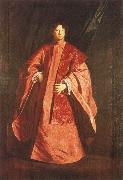 |
Sebastiano Bombelli
|
|
Italian, 1635-1719, Italian painter. He was perhaps the most influential Italian portrait painter of the later 17th century. His early style was formed by his father, Valentino Bombelli, a painter in Udine, and his godfather, the Mannerist artist Girolamo Lugaro. In the early 1660s he was in Venice (Boschini; Sansovino), where he responded passionately to the brilliant colour, painterly freedom and naturalism of 16th-century Venetian artists, particularly Veronese |
|
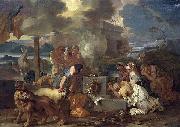 |
Sebastien Bourdon
|
|
(2 February 1616 - 8 May 1671) was a French painter and engraver. His chef d'œuvre is The Crucifixion of St. Peter made for the church of Notre Dame.
The Finding of Moses, c. 1650 (National Gallery of Art, Washington)Bourdon was born in Montpellier, France, the son of a Protestant painter on glass. He was apprenticed to a painter in Paris. In spite of his poverty he managed to get to Rome in 1636; there he studied the paintings of Nicolas Poussin, Claude Lorrain and Caravaggio among his eclectic selection of models, until he was forced to flee in 1638, to escape denunciation by the Inquisition for his Protestant faith. Bourdon's facility rendered him adept at portraiture, whether in a dashing Rubens manner or in intimate, sympathetic bust-length or half-length portraits isolated against plain backgrounds that set a formula for middle-class portraiture for the rest of the century, landscapes in the manner of Gaspar Dughet or cappricci of ruins, mythological "history painting" like other members of Poussin's circle or the genre subjects of the Dutch Bamboccianti who were working in Rome. His eclectic range of styles have given art historians exercise in tracing his adaptation of his models, while the lack of an immediately recognizable "Bourdon style" has somewhat dampened public appreciation.
In 1652 Christina of Sweden made him her first court painter. Bourdon spent most of his working career outside France, where, though he was a founding member of the Academie de peinture et de sculpture (1648), he was for long largely dismissed as a pasticheur, a situation partly rebalanced by a comprehensive exhibition in 2000 of his work at the Musee Fabre, where the collection includes a fine Lamentation painted in the last years of his life.
His success required the establishment of an extensive atelier, where, among his other pupils worked Nicolas-Pierre Loir and Pierre Mosnier. He died in Paris in 1671. |
|
|
|
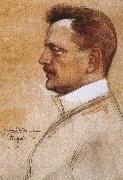 |
sibelius
|
|
Period: Modern (1910-1949)
Country: Finland
Born: December 08, 1865 in Hämeenlinna, Finland
Died: September 20, 1957 in Järvenpää, Finland
Genres: Chamber Music, Choral Music, Concerto, Keyboard Music, Miscellaneous Music, Orchestral Music, Symphony, Vocal Music
|
|
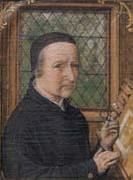 |
Simon Bening
|
|
Flemish Northern Renaissance Manuscript Illuminator, ca.1483-1561
was a 16th century miniature painter of the Ghent-Bruges school, the last major artist of the Netherlandish tradition. Bening was trained in his father Alexander Bening's miniature painting workshop in Ghent. He made his own name after moving to Bruges. His specialty was the book of hours, but by his time these were becoming relatively unfashionable, and only produced for royalty and the very rich. He also created genealogical tables and portable altarpieces on parchment. Many of his finest works are Labours of the Months for Books of Hours which are largely small scale landscapes, at that time a nascent genre of painting. In other respects his style is relatively little developed beyond that of the years before his birth, but his landscapes serve as a link between the 15th century illuminators and Peter Brueghel. His self-portrait and other portraits equally are early examples of the portrait miniature. He served as dean of the calligraphers, booksellers, illuminators, and bookbinders in the Guild of Saint John and Saint Luke. He created books for German rulers, like Cardinal Albrecht of Brandenburg, and royalty like Emperor Charles V and Don Fernando, the Infante of Portugal. The artistic tradition continued in his family. His eldest daughter, Levina Teerlinc |
|
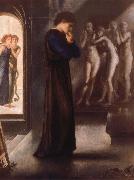 |
Sir Edward Burne-Jones
|
|
Britain 1833-1898
English painter and decorative artist. He was the leading figure in the second phase of the Pre-Raphaelite movement. His paintings of subjects from medieval legend and Classical mythology and his designs for stained glass, tapestry and many other media played an important part in the Aesthetic Movement and the history of international Symbolism. |
|
 |
Sir Edward Coley Burne-Jones
|
|
British Pre-Raphaelite Painter, 1833-1898
English painter and decorative artist. He was the leading figure in the second phase of the Pre-Raphaelite movement. His paintings of subjects from medieval legend and Classical mythology and his designs for stained glass, tapestry and many other media played an important part in the Aesthetic Movement and the history of international Symbolism. |
|
|
|
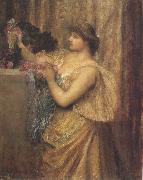 |
Sir edward coley burne-jones,Bt.,A.R.A.,R.W.S
|
|
1833-1898
English painter and decorative artist. He was the leading figure in the second phase of the Pre-Raphaelite movement. His paintings of subjects from medieval legend and Classical mythology and his designs for stained glass, tapestry and many other media played an important part in the Aesthetic Movement and the history of international Symbolism. |
|
|
|
 |
Sir Edward john poynter,bt.,P.R.A
|
|
1836-1919
English painter, draughtsman, decorative designer and museum official. He came from an artistic family: his great-grandfather was Thomas Banks the sculptor, and Ambrose Poynter, his father, was an architect and watercolour painter. Edward began studying art in 1852 under Thomas Shotter Boys, a friend of his father. In 1853-4 Poynter visited Rome, where he was greatly impressed by the large-scale academic painting of Frederic Leighton. Returning to London, he studied at Leigh's Academy and the studio of William Dobson (1817-1898). Poynter entered the Royal Academy Schools in 1855 but his admiration for French painting led him to Charles Gleyre's studio in Paris the following year. He remained there until 1859, with fellow students George Du Maurier, Thomas Armstrong and Whistler; their activities are described in Du Maurier's novel Trilby (1894). At this time Poynter received his first commissions for decorative work. He began designing stained glass and painting furniture and, after his return to England, he was employed by his friend the architect William Burges to decorate the ceiling of Waltham Abbey, Essex, in 1860. |
|
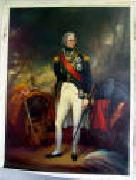 |
Sir William Beechey
|
|
1753-1839
British
English painter. He was trained as a lawyer before entering the Royal Academy Schools, London, in 1772. He is thought to have studied under Johan Zoffany, and his earliest surviving portraits are small-scale full-lengths and conversation pieces in Zoffanys manner (e.g. The Custance Conversation Piece, c. 1786; priv. col.). Beechey first exhibited at the Royal Academy in 1776. In 1782 he moved to Norwich, where he gained several commissions, but he was back in London by 1787. In 1789 he exhibited a portrait of John Douglas, Bishop of Carlisle (London, Lambeth Pal.) that is remarkable for its facility of handling. Beechey would occasionally paint similarly inspired works, but his career is marked by a succession of unflamboyant but competent portraits in the tradition of Joshua Reynolds. |
|
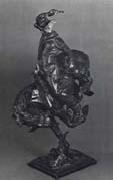 |
Solon H. Borglum
|
|
American Sculptor, 1868-1922,was an American sculptor. Born in Ogden, Utah, he was the younger brother of Gutzon Borglum and uncle of Lincoln Borglum of Mount Rushmore fame. The son of Danish immigrants who settled on the great plains, Solon Borglum spent his early years as a rancher in western Nebraska. Though he later lived in Paris and New York and achieved a reputation as one of America's best sculptors, it was his depiction of frontier life, and especially his experience with cowboys and native American peoples, on which his reputation was founded. Borglum studied under Louis Rebisso in Cleveland and in Paris. He specialized in depicting people and scenes of the American West. He moved to the Silvermine neighborhood of New Canaan, Connecticut, where he helped found the "Knockers Club" of artists. His brother, Gutzon, lived in nearby Stamford, |
|
|
|
|
|
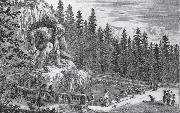 |
Stefano della Bella
|
|
Italian Baroque Era Printmaker, 1610-1664,was an Italian printmaker known for etchings of many subjects, including military ones. He was born at Florence, and apprenticed initially to a goldsmith, but became an engraver working under Orazio Vanni and then Cesare Dandini. He studied etching under Remigio Cantagallina, who had also been the instructor of Jacques Callot, who had lived in Florence 1612-1621, and whose prints imparted a strong influence to printmakers. The patronage of Don Lorenzo de Medici enabled della Bella to study for three years in Rome. In Rome, he created a then admired print of the cavalcade celebrating the entry of the Polish ambassador into Rome in 1633. He also created a number of prints of views of Rome. In 1642 he went to Paris, introduced by the Tuscan ambassador, Alessandro del Nero, and where he resided for seven years. Cardinal Richelieu engaged him to go to Arras and make drawings of the siege and taking of that town by the royal army. After residing a considerable time at Paris he returned to Florence, where he obtained a pension from the grand duke, whose son, Cosimo de Medici, he instructed in drawing. His productions were very numerous, amounting to over 1000 separate pieces. He is known to have illustrated some discoveries for Galileo. See entry for Hansken for his etching of the famous elephant after death. Wikimedia Commons has media related to: Stefano della Bella |
|
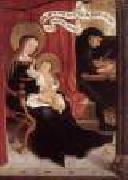 |
STRIGEL, Bernhard
|
|
German Northern Renaissance Painter, ca.1460-1528..Painter, son or nephew of Hans Strigel II. His training with Hans Striegel II shows stylistically in his early works in the Grisons, e.g. the Last Judgement (1486; Brigels, pilgrimage chapel of St Eusebius) and an altarpiece at Disentis (1489; St Johann Baptist). In the 1480s and 1490s he also worked in the studio of Ivo Strigel. Motifs in his pictures stem from engravings by Martin Schongauer and from Ulm book woodcuts. He met Bartholomus Zeitblom as a fellow worker on the high altar (1493-4) of Blaubeuren Abbey, both being influenced by Netherlandish art: Zeitblom by Rogier van der Weyden but Strigel primarily by Dieric Bouts. This influence is also seen in his Adoration of the Magi altarpiece (c. 1500; Memmingen, Stedtmus.). The altar of the Virgin for the monastery at Salem (1507-8; Salem, Schloss) has links with D?rer's graphic work: an increasing three-dimensionality and monumentalization of the objects and figures, and their disposition in space. |
|
|
|
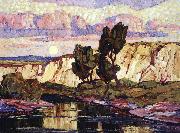 |
Sven Birger Sandzen
|
|
(5 February 1871-19 June 1954), known more commonly as Birger Sandzen, was a Swedish-American painter best known for his landscapes. He produced most of his work while working as an art professor at the Bethany College, Lindsborg, Kansas.
Sandzen was born in Blidsberg, Ulricehamn Municipality, Västra Götaland County, Sweden, the son of a Lutheran minister and his wife, an accomplished watercolorist. A protege of Anders Zorn, Sandzen showed an interest in art at from early age, and at the age of 10 joined Cathedral School (Katedralskolan) situated in Skara, to study art under the tutelage of Olof Erlandsson, a graduate of the Royal Swedish Academy of Arts. After graduating in 1890, Sandzen studied for a short time at the University of Lund before moving to Stockholm. It was his intention to enroll at the Royal Swedish Academy of Arts. However, the waiting list proved too long for him. Instead, he sought out and joined a group of young artists who were studying under Anders Zorn, Richard Bergh and Per Hasselberg. This group would later be known as the Artists League (Konstnärsförbundet).At the end of his studies, Zorn and Bergh recommended that Sandzen complete his painting studies in Paris. In 1894, Sandzen left Stockholm to study under Edmond Aman-Jean who introduced Sandzen to pointillism. |
|
|
|
 |
Taddeo di Bartolo
|
|
Italian Gothic Era Painter, ca.1362-1422
Italian painter. Taddeo, son of the barber Bartolo di Mino, was under 25 in 1386 when he was first recorded, painting statuettes of angels for the new choir-stalls in Siena Cathedral. In 1388-9 he was a counsellor to the Cathedral Works and in 1389 he was first listed as an independent painter. His earliest dated work is the polyptych of the Virgin and Child with Saints (1389; sold London, Christie's, 8 Dec 1950), painted for the chapel of S Paolo at Collegarli, near San Miniato al Tedesco. |
|
|
|
|
|
 |
Thomas Baines
|
|
(27 November 1820 ?C 8 May 1875) was an English artist and explorer of British colonial southern Africa and Australia. Born in King's Lynn, Norfolk, Baines was apprenticed to a coach painter at an early age. When he was 22 he left England for South Africa aboard the "Olivia" (captained by a family friend William Roome) and worked for a while in Cape Town as a scenic and portrait artist, and as official war artist during the so-called Eighth Frontier War for the British Army.
In 1855 Baines joined Augustus Gregory??s 1855?C1857 Royal Geographical Society sponsored expedition across northern Australia as official artist and storekeeper. The expedition??s purpose was to explore the Victoria River district in the north-west and to evaluate the entire northern area of Australia in terms of its suitability for colonial settlement. |
|
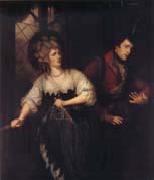 |
Thomas Beach
|
|
British Painter, 1738-1806,English painter. He studied with Joshua Reynolds from 1760 until early in 1762, during which time he was also a student at the St Martin's Lane Academy, London. He probably settled in Bath; his recorded portraits of the 1760s are all of sitters from Dorset or Somerset, and he sent two portraits from an address in Bath to the Society of Artists exhibition of 1772. He exhibited with the Society until 1783, becoming its vice-president (1782) and president (1783) he also exhibited at the Royal Academy (1785-90, 1797). He probably divided his mature practice between London and Bath. His early reliance on Reynolds's ideas of propriety gave way to a more direct approach, seen at its best in such group portraits as The Stapleton Family (1789; U. Bath, Holburne of Menstrie Mus.). In this work, the four children are shown in costume, as a fortune-teller and her customers. The theatrical element in Beach's work, reflecting his interest in the stage, is seen most strikingly in Sarah Siddons and John Philip Kemble in 'Macbeth' Act 2, Scene ii (1786; London, Garrick Club). Beach's diary for 1798, the only one to have survived, chronicles what appears to have been an annual tour of the west country; that year he completed 31 portraits between June and December. Beach was able to capture a strong likeness and this, despite a certain naivety and awkwardness in composition, was enough to establish his reputation in moderately fashionable provincial circles. His last recorded work is a Self-portrait |
|
|
|
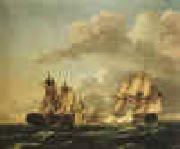 |
Thomas Birch
|
|
1779-1851
Thomas Birch Gallery
American painter of English birth. He was one of the most important American landscape and marine painters of the early 19th century. He moved to America in 1794 with his father William Birch (1755-1834), a painter and engraver from whom he received his artistic training. The family settled in Philadelphia, where William, armed with letters of introduction from Benjamin West to leading citizens of that city, became a drawing-master. Early in their American careers both Birches executed cityscapes, several of which were engraved. Thomas contributed a number of compositions to The City of Philadelphia in the State of Pennsylvania, North America, as it Appeared in the Year 1800 (1800), a series of views conceived by the elder Birch in obvious imitation of comparable British productions. An English sensibility is also apparent in the many paintings of country estates executed by father and son in the early 19th century (e.g. Eaglesfield, 1808; priv. col.). These compositions, along with such portrayals of important public edifices in and near Philadelphia as Fairmount Waterworks (1821; Philadelphia, PA Acad. F.A.), emphasize the cultural progress and commercial prosperity of the young United States as well as its almost Edenic natural beauty. Birch is also known for his representations of winter landscapes. |
|
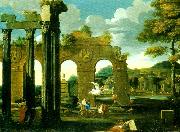 |
Thomas Blanchet
|
|
Thomas Blanchet (1614, possibly in Paris - 21 June 1689, Lyon) was a French painter, draughtsman, architect, sculptor and printmaker.
During his training in Paris Blanchet met Jacques Sarazin, and on his advice moved from studying sculpture to painting. During this time he familiarised himself with the Baroque and the School of Fontainebleau's Mannerism, new imports into Paris at this time. Among his probably co-students was Simon Vouet. He stayed in Rome from c.1645 to 1653 and worked with artists in Nicolas Poussin's circle, as well as visiting the studios of Andrea Sacchi and Pietro da Cortona. He was highly praised by Gianlorenzo Bernini, who he also visited. Blanchet produced paintings for Niccolo Guido di Bagno (1584 -1663), made engravings of ancient tombs and views or prospettive and a mausoleum for Rene de Voyer d'Argenson, French ambassador to Venice in San Giobbe, Venice (1654). |
|
|
|
|
|
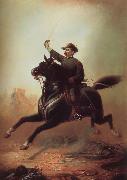 |
Thomas Buchanan Read
|
|
American Painter, 1822-1872,was an American poet and portrait painter born in Chester County, Pennsylvania. Read wrote a prose romance, The Pilgrims of the Great St. Bernard, and several books of poetry, including The New Pastoral, The House by the Sea, Sylvia, and A Summer Story. Some of the shorter pieces included in these, e.g., "Sheridan's Ride," "Drifting,""The Angler", "The Oath," and "The Closing Scene," have great merit. Read was briefly associated with the Pre-Raphaelite Brotherhood. His greatest artistic popularity took place in Florence. Among portraits he painted were Abraham Lincoln, Henry Longfellow, Alfred Tennyson, Elizabeth Barrett Browning, Robert Browning and William Henry Harrison. Read died from injuries sustained in a carriage accident, which weakened him and led him to contract pneumonia while on shipboard returning to America. |
|
|
|
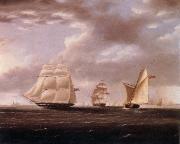 |
Thomas Buttersworth
|
|
English Painter, 1768-1828, He was a seaman of the Napoleonic wars period who became a maritime painter producing works to commission, and was little exhibited during his lifetime. He was born on the Isle of Wight, England. He enlisted in the Royal Navy in London in 1795, and served on HMS Caroline during the wars with France, then was invalided home from Minorca in 1800. The National Maritime Museum in London has 27 watercolours by him, several of which are mounted on sheets from 18th century printed signal and muster books. |
|
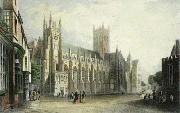 |
Thomas Mann Baynes
|
|
(1794 ?C 1876) was a London born English artist known for his drawings and watercolours of landscapes, buildings and outdoor events. Many of his subjects were engraved and published, generally in London, and these include a notable panorama of the River Thames, which was drawn from nature and engraved on stone. He was the son of James Baynes, a noted watercolour artist.
Baynes also produced views of Liverpool and Ireland, and appears to have made a successful living as a printer prior to his death in 1854. His son Fredrick Thomas Baynes (1824-1874) was also a noted watercolour artist.
|
|
|
|
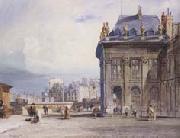 |
Thomas Shotter Boys
|
|
English Engraver, 1803-1874
English painter and printmaker. He was apprenticed on 4 February 1817 to George Cooke. His early training in engraving influenced his future career; his ability to draw a fine line, lay aquatint washes and hand-colour prints was an important factor in the creation of his particularly lucid style of watercolour landscapes and townscapes. At this time Cooke was engraving volumes of picturesque views by Turner and James Hakewell (1778-1843) as well as his own view of the Thames (1822); |
|
|
|
|
|
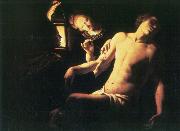 |
Trophime Bigot
|
|
Trophime Bigot (1579-1649/50), also known as Theophile Bigot, Teofili Trufemondi, Candlelight Master, Maître e la Chandelle, was a French painter of the Baroque era, active in Rome and his native Provence.
Bigot was born in Arles in 1579, where he began his artistic career. Between 1620 and 1634, Bigot was in Italy, including Rome. He is known to have been in Arles in 1634, where he painted the altarpiece Saint Laurent condamne au supplice (Saint Laurence Condemned to Torture) and Assomption de la Vierge (Assumption of the Virgin) for local churches.
Between 1638 and 1642, he lived in Aix-en-Provence, where he painted another Assumption of the Virgin. He returned to Arles in 1642, and divided his activities between this city and Avignon, where he died around 1650. |
|
|
|
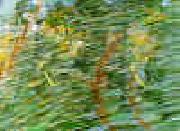 |
Umberto Boccioni
|
|
1882-1916
Italian
Umberto Boccioni Locations
Italian sculptor, painter, printmaker and writer. As one of the principal figures of FUTURISM, he helped shape the movements revolutionary aesthetic as a theorist as well as through his art. In spite of the brevity of his life, his concern with dynamism of form and with the breakdown of solid mass in his sculpture continued to influence other artists long after his death. |
|
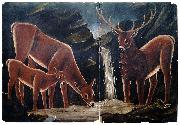 |
Vaclav Brozik
|
|
(5 March 1851 - 15 April 1901) was a Czech academic painter.
Since 1868 he studied at the Academy of Arts in Prague, Dresden, and Munich. In 1879 he went on study journey to the Netherlands.
He married a daughter of a wealthy art dealer in Paris, who helped him achieve success in French high society. He divided his time between Prague, where he taught at the Academy since 1893, and Paris. In 1896 he was elected as a foreign member and the successor of John Millais in the French Academie des beaux-arts. He died suddenly of cardiac failure and is buried at the Cimetiere de Montmartre.
|
|
|
|
|

